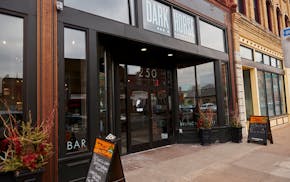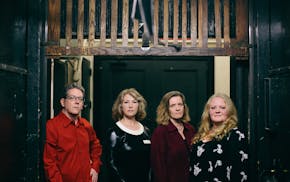Among the vintage bungalows and Tudors in Minneapolis' Bryn Mawr neighborhood, one house sports a distinctive South Pacific vibe.
The house is home to Paul Linnebach, owner of Mantis Design + Build, who was inspired by a memorable trip to transform his own 1920s Craftsman into a Shangri La for his family of five.
"I like to make things magical and interesting," he said. "I get a lot of inspiration from overseas travel."
His home's makeover is an homage to Bali, "a beautiful paradise" where the culture is as inspiring as the tropical setting, he said. "The Balinese spend a lot of time in reverence and gratitude for the blessings they receive. It's a very spiritual culture, a really sweet culture."
A Balinese makeover for a Midwestern Craftsman house isn't as outlandish as it might seem.
"Craftsman was inspired by Japanese architecture, and that influenced Balinese architecture," Linnebach said. "I wanted to create a modern global Craftsman — in a way that feels artful and balanced."
Before his home's magical transformation it was a "little Granny house" that Linnebach and his wife, Katrina, bought in 2004 after an eight-year stint living on the Yucatán Peninsula of Mexico, where they managed a resort.
"We were looking to raise children in the U.S.," said Linnebach, a California native.
During their time in Mexico, they met Minnesotans who flocked there in winter — so many that the Linnebachs referred to February as "Minnesota month." Some of the snowbirds became their friends. "They said, 'Come to Minnesota. It's a great place to raise a family.' "
So the Linnebachs moved north and found their house in Bryn Mawr. "It was in a state of needing some love," he said. The exterior, in particular, hadn't been touched for decades.
After living in the "simple Minnesota house" for about 15 years, Linnebach decided it was time to give it a major makeover.
He redesigned his home's "underwhelming" entry to create a covered front porch accented with cedar brackets and a dramatic roofline that give it the presence of a Buddhist temple.
"I appreciate nice entries. In California, they were part of the welcoming experience," he said. His porch is now "an urban temple — to shelter us from rain and snow."
The serene porch has a stamped concrete floor and a cedar ceiling highlighted with a handmade copper light fixture from Bali. On one side of the porch hangs a copper rain chain that burbles to life during downpours.
"It's a very Zen thing," said Linnebach. "You can sit on the porch when it's raining, and it's like your own little water feature."
The home's entire exterior was transformed from drab to dramatic. Its most distinctive feature is its base, which is clad in wafers of slate stone, inspired by stone pots the family brought back from Bali. The slender stones register visually as softer than the larger stones that Western eyes are accustomed to seeing, Linnebach said.
"A typical stone wall has stones that are 8 inches in diameter," he said. "These are very thin."
Laying the thin stones was challenging and time-consuming, he said. "Each piece is laid individually, for a drystack look. I had masons help me with that."
Above the stone is fiber-cement lap siding of staggered sizes to evoke the striations of the Earth. "It's playful, yet still well thought out," he said. The trim boards are a fiber-based product stained to emulate natural cedar. A bumpout is clad in natural cedar, adding an element of warmth.
"My wife wanted no maintenance; I'm a wood lover," he said. "We hit the more important areas with real wood and others with minimal-maintenance composite."
Backyard paradise
While redoing his home's exterior, Linnebach also transformed his basement and backyard.
Before, "it was a typical Minneapolis basement," he said, dark and unfinished with a low ceiling. "We called it the dungeon."
He had the main floor raised, and the basement re-excavated to create a lower-level walkout with 9-foot ceilings. "It doesn't feel like a basement," he said. The bedroom and bathroom on the lower level have translucent resin windows that emit light while preserving privacy.
Before the project, Linnebach's backyard had such a steep slope that it was mostly unusable. He removed a deteriorating rear porch, then regraded, terraced and landscaped. The Linnebachs got a lot of plants from neighbors who were dividing their hostas, he said, then added big-leaf tropicals such as cannas and bananas for exotic flair.
The centerpiece of the backyard is a large patio where the family can enjoy the outdoors and dine al fresco at a teak table.
"I wanted a really big table," he said. "Now we can have 20 people in the backyard comfortably. We love getting outside and sharing with friends and family. The setting is magical."
Having a backyard oasis has been a godsend during the COVID pandemic. The Linnebachs limited their gatherings this year, but when they did invite a few people to join them on their patio, they were able to spread everyone out and social-distance.
Transforming the home's exterior and outdoor space was a major and expensive undertaking. Linnebach did a lot of the work himself, including all design, building the brackets, installing the gutters and painting, staining and sealing. He worked with his firm's crew on other aspects of the project, which helped reduce his costs. A comparable exterior project would cost about $120,000, he estimated.
It was a worthwhile investment because it transformed the way his family experiences their home. "We cherish our summers in such a different way," he said.
And his Balinese-inspired house is now ready for its next century.
"The house has another 100 years in it," he said. "It's great to give this house new life."

The 5 best things our food writers ate this week

A Minnesota field guide to snow shovels: Which one's best?

Summer Camp Guide: Find your best ones here

Lowertown St. Paul losing another restaurant as Dark Horse announces closing

